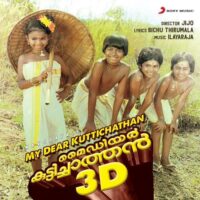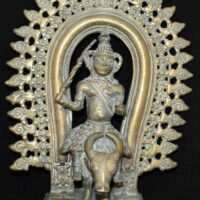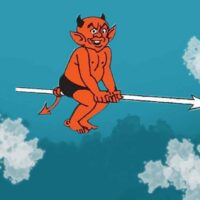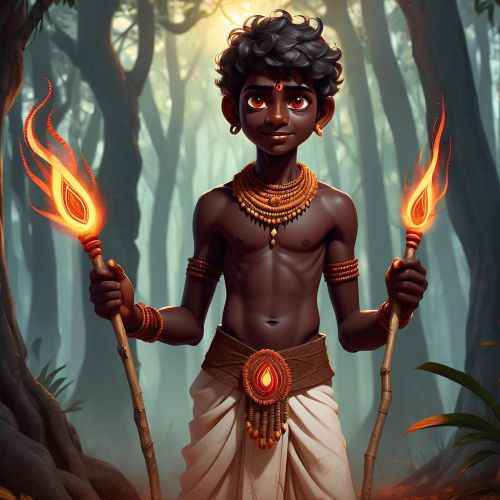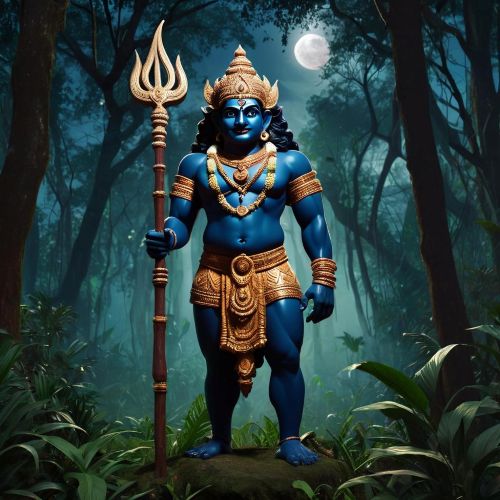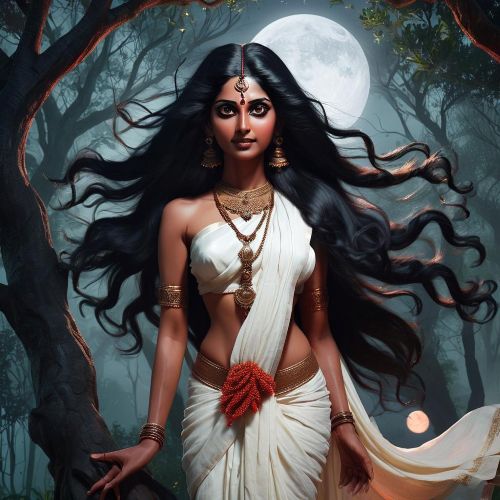Kuttichathan : The Playful Trickster Spirit of Kerala
Listen
At a glance
| Description | |
|---|---|
| Origin | Indian Mythology |
| Classification | Spirits |
| Family Members | N/A |
| Region | India |
| Associated With | Magic, Mischief |
Kuttichatan
Introduction
Kuttichathan, a supernatural being deeply rooted in Kerala’s folklore, occupies a complex role in South Indian mythology. The name is often translated as “little ghost” or “child spirit,” though the figure is far more than a wandering soul. Kuttichathan is venerated in temples dedicated to Vishnumaya, a deity believed to manifest through him, and is associated with both protective and magical powers. For centuries, families and communities in Kerala have sought his blessings to remove obstacles, ward off enemies, and overcome misfortune. Unlike purely benevolent deities, Kuttichathan embodies dual qualities: mischievous and playful, yet also capable of bestowing immense protection. This balance between trickster energy and divine guardianship makes him one of the most intriguing figures in Kerala’s spiritual traditions.
Physical Traits
Descriptions of Kuttichathan highlight his unique blend of innocence and mischief. He is most often portrayed as an adolescent boy, around twelve years of age, with a childlike face and an impish smile. His hair is tied into a kutumi, a traditional topknot, which emphasizes his youthful appearance. Though he is not considered a dwarf, his small and compact form gives him an everlasting boyhood charm. In ritual performances such as Theyyam, he is depicted with striking face paint, bulging eyes, and elaborate costumes that bring out his fiery personality. Some depictions also include horns or sharp teeth, symbolizing his wilder and more fearsome side. This dual representation—playful child and fierce protector—captures the paradox at the heart of Kuttichathan’s myth.
Family
The origins of Kuttichathan are told through several overlapping traditions. In the most widespread belief, he is identified with Vishnumaya, the son of Lord Shiva. According to legend, Shiva assumed the form of a tribal man to unite with a woman of the forest, and from this union was born Vishnumaya, affectionately called Chathan. Because of his small size and eternal youth, he came to be known as Kuttichathan, meaning “little Chathan.” Another tradition claims that 400 beings resembling Chathan were created, making it impossible to distinguish the original, but ultimately 390 joined him as divine protectors of the Malayan tribal community. This myth underscores his role as both a deity of the marginalized and a spiritual guardian tied to Kerala’s indigenous traditions. In other versions, he is portrayed as a Bhootha Gana, one of Shiva’s attendants, who descended to Earth to carry out protective tasks. This diversity of origin stories reflects the wide reach of Kuttichathan’s worship across Kerala’s religious landscape.
Other names
Kuttichathan is known by a range of names, each reflecting different aspects of his identity. He is frequently called Vishnumaya Kuttichathan, which emphasizes his association with the divine protector Vishnumaya. In certain rituals and folklore, he is referred to simply as Chathan, a term derived from the Sanskrit “Sastha,” though it should not be confused with the Western concept of Satan. In the ritual art form of Theyyam, particularly popular in northern Kerala, he is honored as Sasthappan Theyyam or Kuttichathan Theyyam, where his mischievous and protective qualities are celebrated in elaborate performances. Another popular epithet is Karinkutti Chathan, used in some folk traditions to describe his darker and more fearsome form. The variety of names illustrates the adaptability of Kuttichathan’s persona in different cultural and ritual settings.
Powers and Abilities
Kuttichathan is celebrated for his mastery of magical and supernatural abilities. He is often invoked for his power to grant wishes, especially when worshippers make offerings in temples dedicated to Vishnumaya. His protective nature ensures that devotees are shielded from black magic, curses, and hostile forces. Folklore describes his playful side through pranks, such as hiding household objects, throwing stones, or creating noises at night. These mischievous acts, though disruptive, are rarely harmful, serving instead as reminders of his presence. Beyond pranks, Kuttichathan is revered for his ability to generate illusions, or maya, that test the devotion and resilience of those who encounter him. In many depictions, he is shown riding a buffalo, an image that symbolizes his strength and authority over supernatural forces. Ritual practices, including Chaathan Seva, focus on harnessing these powers, whether for protection, prosperity, or overcoming obstacles. His role as both a trickster and a protector highlights his importance in the spiritual life of Kerala’s communities.
Modern Day Influence
The legacy of Kuttichathan continues to shape Kerala’s culture, blending tradition with modern reinterpretations. One of the most enduring expressions of his worship is Kuttichathan Theyyam, a ritual performance that brings his stories to life through music, dance, and vibrant costume. These performances are not only spiritual ceremonies but also cultural spectacles that attract audiences across the region.
In popular media, Kuttichathan achieved iconic status through the 1984 Malayalam film My Dear Kuttichathan, India’s first 3D movie. The film portrayed him as a magical companion to children, blending folklore with fantasy in a way that resonated across generations. Its commercial success helped introduce the figure to a broader audience, ensuring that his legend reached beyond traditional ritual spaces. Later films and television references continued to explore his character, sometimes highlighting his mischievous antics, other times portraying him as a benevolent protector.
Kuttichathan also holds a significant place in literature. Modern writers have reimagined his tales, portraying him as a spirit who embodies both wisdom and mischief, often teaching lessons through his actions. Works like Whispers of the Mischievous Spirit: The Legend of Kuttichathan by Swati Bisht and Child of Shadows: The Mystical Tales of Kuttichathan contribute to keeping his narrative alive in contemporary storytelling.
Even in daily life, belief in Kuttichathan’s presence persists. In rural Kerala, unexplained disturbances—such as misplaced items, flickering lamps, or strange nighttime sounds—are often attributed to his antics. Families still visit Vishnumaya temples, making offerings to seek his blessings for protection, wealth, and relief from adversity. His presence in both sacred and secular contexts ensures that Kuttichathan remains an enduring figure, embodying Kerala’s rich blend of folklore, ritual, and cultural imagination.
Related Images
Source
Lectures on Ethnography by L. K. Ananthakrishna Iyer (1925) https://archive.org/details/in.ernet.dli.2015.70013
Witchcraft in Western India by Sohaila Kapur (1983) https://archive.org/details/witchcraftinwest0000kapu
Who is Kuttichathan? – Dharma Pulse https://dharmapulse.com/who-is-kuttichathan/
Kuttichathan: Kerala’s Mischievous Spirit and Its Legends – Decode Malayalam https://decodemalayalam.com/kuttichathan-legends-guide/
Bisht, S. (n.d.). Child of Shadows: The Mystical Tales of Kuttichathan.
Bisht, S. (n.d.). Whispers of the Mischievous Spirit: The Legend of Kuttichathan.
DC Books. (2019, January 01). KUTTICHATHAN, AYYAPPAN, SASTHAV.
Frequently Asked Questions
Who is Kuttichathan in Kerala mythology?
Kuttichathan is a mischievous spirit from Kerala folklore, often depicted as a small, childlike being who plays tricks on humans while possessing magical powers.
What powers does Kuttichathan have?
He is believed to have the ability to shape-shift, create illusions, and bring both fortune and chaos depending on how he is treated or invoked.
Is Kuttichathan considered good or evil?
Kuttichathan embodies duality—he can be benevolent to those who respect him and vengeful toward those who try to control or deceive him.
What are Kuttichathan temples known for?
Temples dedicated to Kuttichathan, such as those in northern Kerala, are famous for rituals and performances that blend devotion, exorcism, and folklore.
How is Kuttichathan represented in modern culture?
Kuttichathan remains a popular figure in Kerala’s art, films, and theatre, often portrayed as a witty and rebellious spirit who challenges social and spiritual norms.


